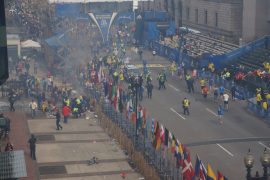We can all agree that the horrific events at Monday’s Boston Marathon sent a chill down our country’s collective spine. The two bombs that exploded have made us afraid and sad and hopeless. One message that seemed to ease many’s pain and fear was from Mr. Rogers, who once said:
When I was a boy and I would see scary things in the news, my mother would say to me, ‘Look for the helpers. You will always find people who are helping.’ – Fred Rogers
This is an amazing idea in the midst of the mayhem and terror that followed the explosions. There were dozens and dozens and dozens of people who ran toward the bomb sites, because that’s what they do – help those in need.
In the days that have followed, the FBI and others have been investigating the explosions, gathering information that will likely lead to an arrest and hopefully a conviction. Our natural question in these situations is, “Why?” Catching the person or people who did this will help us find that answer.
It shouldn’t surprise you to know that these investigators will depend on mathematics to help them solve this crime. From measuring the trajectory of the shrapnel to piecing together a timeline of events, math is a critical component in investigation.
A while back, I had the pleasure of interviewing Mary Ellen O’Toole, a former FBI profiler and author of Dangerous Instincts: How Gut Feelings Betray Us. She answered my questions about how she used math as a profiler. And I’m betting that this holds true for the investigation in Boston, as well.

Math at Work Monday: Mary Ellen the FBI profiler
Can you explain what you do for a living?
For half of my career, I worked in Quantico, at the FBI’s Behavioral Analysis Unit, the very unit that is the focus of the television show Criminal Minds. While there I tracked down, studied, and interviewed some of the world’s most infamous criminals, and I analyzed their crime scenes, too. These criminals included Gary Ridgeway (the Green River Killer), Ted Kaczynski (the Unabomber) and Derrick Todd Lee (the serial killer of Baton Rouge.) I worked everything from white-collar crime to work place and school violence to kidnappings to serial murder.
Since my retirement in 2009, I’ve worked as a consultant to law enforcement, corporate security, administrators, and many other professionals. I also teach at the Smithsonian, FBI Academy and many other locations.
When do you use basic math in your job?
As I and other profilers worked to solve a crime, we used every type of math from basic addition to geometry and pattern analysis to statistics and probability to reasoning and logic.
Read the rest of the interview.
If you’d like to share your wishes for the victims of the Boston Marathon bombing, please feel free to do so in the comments section.
